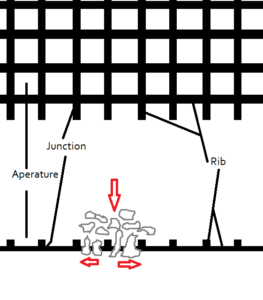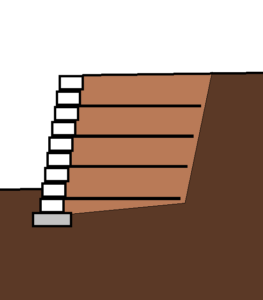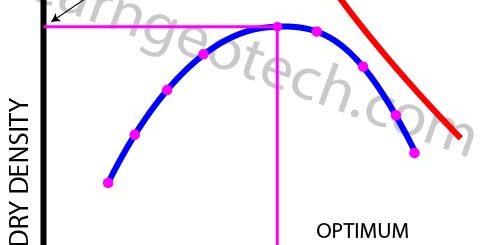How Does Geogrid Work?
In general, geogrid is used to distribute concentrated loads over a wider area – sometimes under footings, roadways, or other areas that require subgrade support. Geogrid’s other most common use is to act as reinforcement in a retaining wall. In this article, I will cover both cases. If you’re a homeowner or builder, and you just want to know if geogrid is worth the investment – it is. It’s relatively inexpensive and will make your driveway, patio, subgrade much stronger.
The most common types of geogrid are uniaxial, biaxial and triaxial grids. Grid type is selected based on the type of loading the soil is expected to encounter. In a retaining wall, the primary expected loading is perpendicular to the wall face, so uniaxial grids are used in retaining walls. In applications such as roadways and parking lots, where loading can be in any direction, a biaxial or triaxial grid should be used.
How does Geogrid Work in Road Construction?
I’ve had a lot of contractors ask me “What does geogrid do in road construction?”. The answer is simple, but the explanation is not. In short, geogrid spreads concentrated loads from the vehicles on the road over a wider area, reducing settlement. This is the answer I usually give on-site, and most of the time it satisfies whoever has asked me the question. I had repeated this a few times to myself, before wondering to myself – “why, why does geogrid work this way? what does it actually DO?”
So, I did some research, asked some senior engineers, took some notes and wrote this article. And for it, I’m more confident in my knowledge and have gained a more intimate understanding of one of the most common geotechnical technologies we use.
Soil, by nature, does not behave as a single solid mass. As a system of individual particles, most of the soil’s strength comes from interparticle friction.
I want you to imagine a cube of soil consisting of sand, and confined on all sides (except the top of course). If you were to push down on the top of the cube, you would expect the sand to give way for some distance, and then you would meet resistance. This resistance is from all the tiny pieces of sand rubbing against each other, squeezing together, and eventually getting to the point where all those tiny bits of sand experiencing friction, equal the force that you are exerting on the top of the sand. (If you would like a more in-depth explanation of this phenomenon, please read my article on friction angles.)
But, your hand has pushed into the sand. Settlement.
We don’t like settlement. By using geogrid, the particles of sand would find something solid to push against much sooner. Something they couldn’t slide past. The force exerted onto the particles of sand would instead be transferred into the geogrid as they find themselves interlocked within the geogrid. The geogrid provides tensile resistance that is much stronger than the frictional forces that were at first providing resistance to your hand.

The geogrid is able to transfer the load experienced by the soil by allowing some of the interlocking particles within the soil to penetrate through the apertures of the grid. The particles which have penetrated through the aperture are then forced into the ribs of the geogrid by the pressures above, causing the ribs to experience tension, and spreading the loading over the surface area of the grid.
This larger surface area means less pressure on the soils below the grid, less movement for the soils above the grid, less settlement of the surface, and an all-around improved strength of the soil structure. For such basic technology, it really is quite impressive. If you’re building a driveway for your home, definitely make sure your contractor is using geogrid. It’s cheap and highly effective.
How Does Geogrid Work in Retaining Walls?
Most of the time, uniaxial geogrids are used in retaining walls. A uniaxial geogrid doesn’t work quite the same way as a biaxial or triaxial grid that we discussed above because a uniaxial grid can only be loaded in one direction – along its strong axis. This means that it doesn’t control settlement so much as it acts as an anchor.
On a uniaxial geogrid, you can easily see which axis is the strong axis. It is thicker and stiffer than the thinner pieces of fabric/thread holding the grid together. When building a retaining wall, the thick axis should run perpendicular to the face of the retaining wall. This is critical to the performance of the grid, and by extension, the wall.
Uniaxial geogrid uses the soil’s own weight to support the wall, effectively anchoring the wall to the soil and causing the entire retained soil body to act as a singular mass with the wall, holding back the unreinforced soil behind. The grid is placed on top of a block course and then pinned by the next course of blocks, making sure that the grid is positioned such that its strong axis is perpendicular to the wall face. The approved design backfill material should then be placed at the wall and compacted towards the end of the grid, further tensioning the grid.

Note that a properly designed retaining wall should have a drainage system. I have left that out in this drawing for clarity.
The light brown soil is reinforced by the geogrid, and is pulling the wall blocks back into the soil, using the soils own force against the wall to also hold the wall up. This locks the retained soil and blocks together, causing the entire mass to act against the unreinforced soil, thereby retaining it. Geogrid placement and lengths are important factors and are to be decided by the design engineer. As geogrids are rated for different long term design strengths, hiring an engineer to design a reinforced wall is an important step that should not be overlooked.
Take a look at this YouTube video to see how much of an impact geogrid can have on the strength of a subgrade.
As an Amazon Associate I earn from qualifying purchases.

